A few years ago, Sony and Panasonic each released a rangefinder-esque mirrorless model that would go on to define their respective paths within the mirrorless sector.
On one hand, there was the Lumix GX7, which could be called Panasonic’s first high-end still photography model because prior to its release in 2013, most premium products had a stronger focus on video. On the other, we had the Sony a6000, which following its release in 2014 became the best-selling mirrorless model on the market because it struck the perfect balance between advanced features and affordability.
Now the successors to these models have arrived in the form of the Sony a6300 and Lumix GX85, and it is just as difficult to choose between them as it was to choose between their predecessors! As such, we’ve put together this in-depth comparison to help you understand which model might be more suitable for your photographic needs. Let’s get started!
[toc heading_levels=”2″]
Ethics Statement: We bought both the Sony a6300 and Panasonic GX85 for our personal use. We were not asked to write anything about these products, nor were we provided with any sort of compensation. Within the article, there are affiliate links. If you buy something after clicking the link, we will receive a small commission. To know more about our ethics, you can visit our full disclosure page. Thank you!
Design, Ergonomics and Ease of Use
Both the a6300 and GX85 have the look of a modern rangefinder, characterised by the placement of the electronic viewfinder on the left-hand side of the body.
Looking at the two cameras side-by-side, they appear more or less the same size. The GX85 is a little heavier than the a6300 (426g versus 404g with the battery and SD card) but their dimensions are comparable (120 x 66.9 x 48.8 mm for the a6300 and 122 x 70.6 x 43.9 mm for the GX85).
Although both have a protruding grip out front, the a6300’s is more substantial, making it somewhat more comfortable to use with telephoto lenses. Turn to the rear and you’ll find a small thumb rest. Both cameras are covered in synthetic leather to improve the handling.
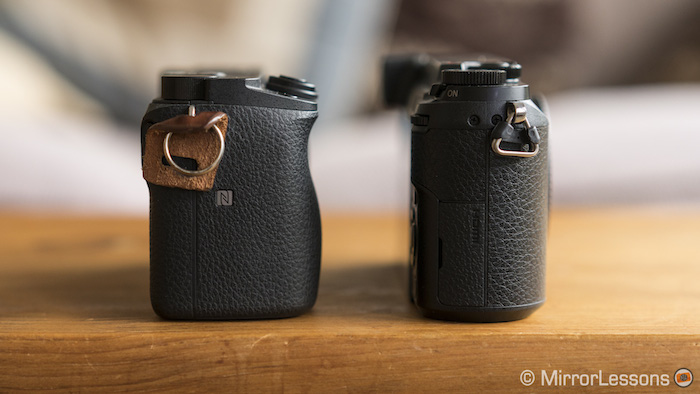
An important difference is that only the a6300 is dust and splash resistant. It is likely the GX85 wasn’t given weather resistance to keep the price down.
Those accustomed to dedicated dials for the main exposure settings such as shutter speed, ISO and exposure compensation may face a small learning curve when using either camera for the first time.

To change the exposure on the GX85, you must use the front and rear control dials. When in Aperture priority, for example, one dial controls the aperture and you can assign exposure compensation to the other. The a6300, on the other hand, only has one control dial. In the place of a second dial, there is a rear control wheel. It works but isn’t always as comfortable to use as a proper dial. As for the ISO sensitivity, it is natively accessible from the four-way control pad on both cameras.
Both come with the ubiquitous PSAM dial on the top plate and the options displayed on the dial are nearly identical.
In addition to the standard Aperture/Shutter/Program/Manual modes, the Automatic, Panorama, Scene, and Movie modes are also present, along with a preset option called C (Custom) on the GX85 and 1 and 2 (Memory Recall 1 and 2) on the a6300. One mode dial setting exclusive to the GX85 is called Creative Control, a fancy synonym for art filters. To access the same kind of art filters on the a6300, you must enter the menu and select Picture Effect.
Other features found on the top plate include a hot shoe for extra accessories and a pop-up flash. Note that neither built-in flash can control an external unit wirelessly. On the GX85 you need to buy the optional Panasonic FL200L. For the a6300 you will need a compatible external flash like the HVL-F20M.
On the GX85, the shutter release button is nestled in the middle of the control dial, while on the a6300, it sits on top of the grip surrounded by the on/off button.
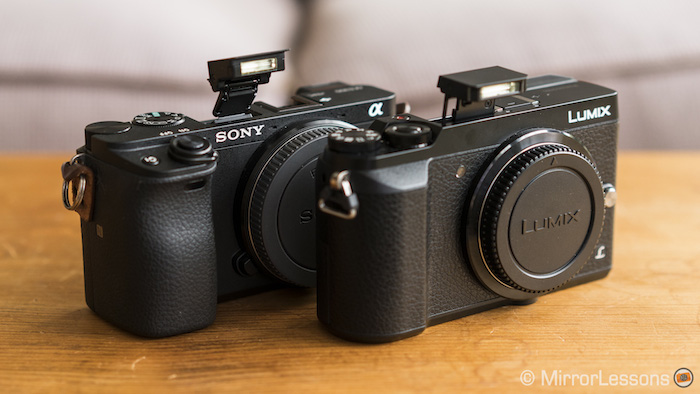
Although both have a dedicated movie button, neither is easy to press or reach. The GX85’s is found on the top plate but being so small and flush with the body, it requires a press or two to activate. The a6300’s is on the thumb grip and feels overly recessed.
Moving to the rear, the first thing you’ll notice on both cameras is a 3-inch LCD monitor that tilts up 90 degrees and down 45 degrees. Avid video shooters might miss a fully articulating screen but adding one would have increased the size of both cameras.
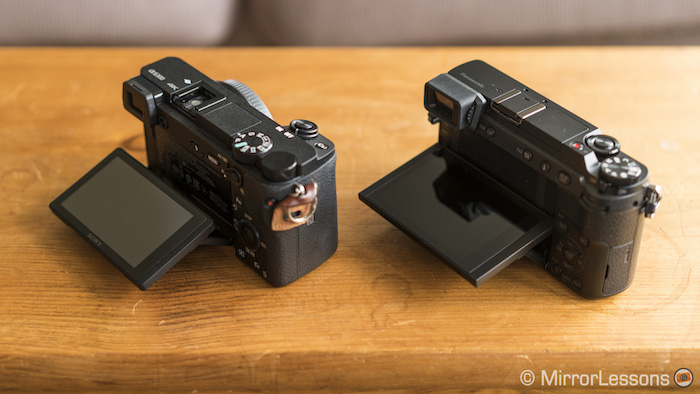
Only the GX85’s monitor offers touch sensitivity and we consider this a huge point in its favour. With it you can change the position and size of the AF point, take a picture, and scroll through the menu or your images. It is one of those features you don’t miss until you’ve tried it, and never stop praising once you have. Although Sony is capable of touch technology, they’ve chosen to reserve it for their entry-level models for the time being (namely the a5100).
The rear is abound with various buttons, of which four are customisable on the GX85 versus the nine of the a6300. However, you can also customise five extra “virtual” buttons on the GX85’s on-screen interface. On the a6300, you can assign an impressive 64 different functions to these customisable buttons in shooting mode, as well as 6 in playback mode, overshadowing the 14 in shooting mode and 7 in playback mode on the GX85.
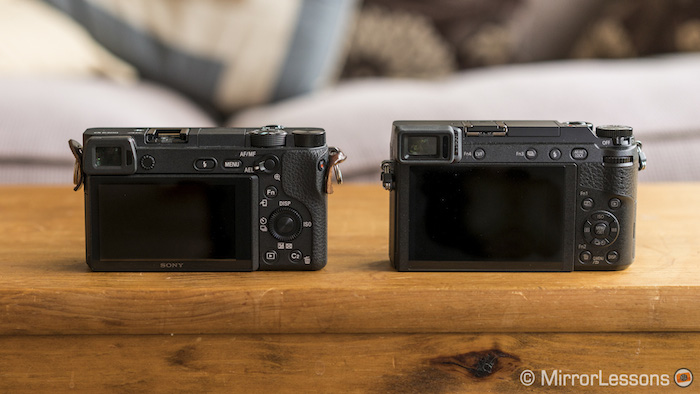
Also on the rear of both cameras is an electronic viewfinder (EVF) which, as mentioned above, sits on the left in true rangefinder style.

While the official specifications state that the GX85’s EVF has an equivalent resolution of 2.76 million dots, the native resolution is actually lower because it uses a field sequential LCD panel. (We believe it is close to 922K.) It is for this reason also that you’ll sometimes encounter rainbow artefacts within the finder. It has a maximum refresh rate of 60fps and a 16:9 aspect ratio, which is useful for video but can be problematic for still shooting in 4:3 since the image gets sandwiched between two black bars on the left and right.
The a6300’s EVF has a native resolution of 2.36 million dots and a maximum 100fps refresh rate (120fps in NTSC mode). It sports an XGA (OLED) screen which is brighter and does a better job of reproducing natural colours, and has a 3:2 aspect ratio to match its sensor. When shooting video with the 16:9 aspect ratio, the image once again gets sandwiched but this time, the black bars appear at the top and bottom.
Both the GX85 and a6300’s EVFs have 0.70x magnification, 100% field coverage, and an uninterrupted Live View option in continuous shooting mode, which is available up to 6fps and 8fps respectively.
Turning to their respective menu systems, what will immediately strike you is how much more organised and straightforward the GX85 menu is compared to the a6300. In fact, of all mirrorless menu interfaces we’ve tried, with the exception of the menu found on the latest Fujifilm models, Panasonic’s is the most user-friendly.

Usefully, both cameras come with a customisable quick menu that is accessible via the Fn button on the a6300 and the Fn2 button on the GX85. From here, you can rapidly access your most used settings.
Following complaints about extreme shutter shock between 1/60 and 1/320 on some GX8 models, Panasonic opted to give the GX85 a brand new shutter mechanism that reduces shutter shock by 90%. Happily, we haven’t encountered any shutter shock from either the a6300 or the GX85 in our tests.
Finally, we come to the various ports found to one side of the two cameras. While both have an HDMI and USB port, only the a6300 has a microphone input. The USB port can be used to charge the camera battery, so you don’t need an external charger.
Image Quality: The sensor
The a6300 has a new 24MP APS-C sized sensor with copper wiring incorporated into the structure to improve light collecting efficiency. This makes it one of the best performers at the higher ISO values.
The GX85 has a 16MP Micro Four Thirds sized sensor. Due to the removal of the low-pass filter in front of the sensor, it is said to offer 10% more resolution than previous 16MP Micro Four Thirds sensors.
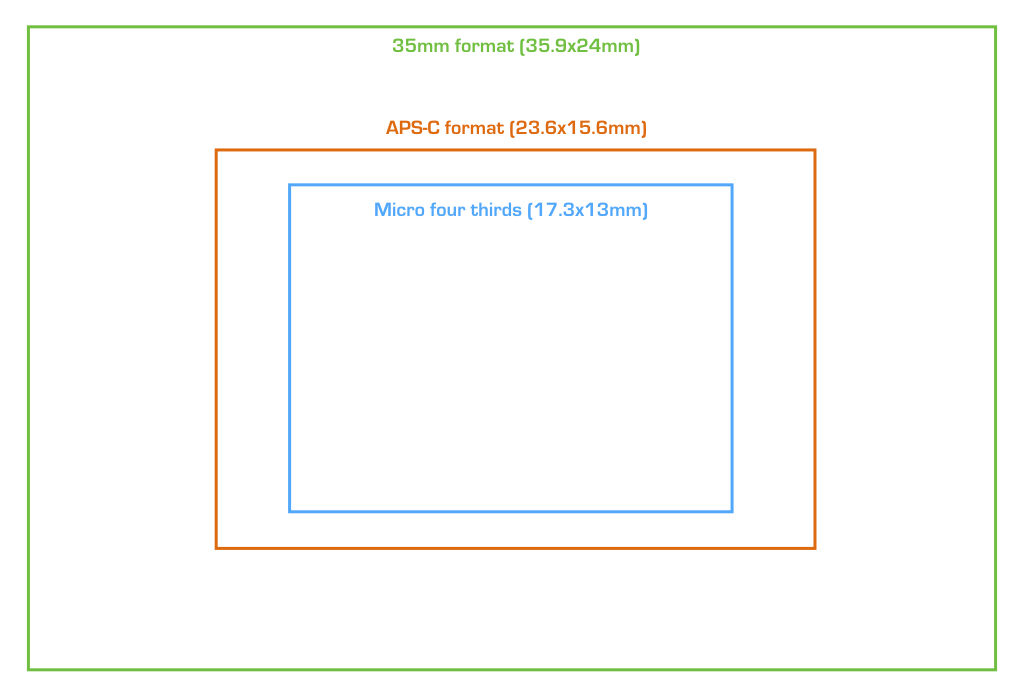
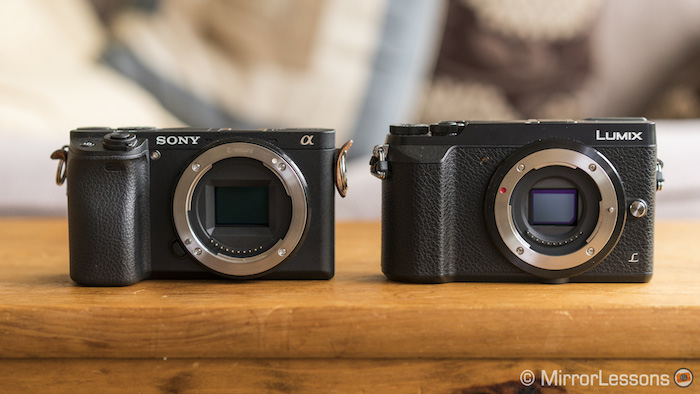
To see how the two sensors perform against one another, I compared the resolution, dynamic range, white balance and high ISO performance. To achieve a similar field of view, I used the FE 55mm f/1.8 (a full-frame prime) on the a6300 to have the equivalent of 85mm in full-frame terms, and the Lumix 35-100mm at around 42mm on the GX85 to achieve a field of view that was as close to 85mm as possible.
Resolution
Given the difference in optical quality between the two lenses used for this comparison, it is impossible to compare resolution and sharpness with 100% accuracy. However, it goes without saying that 24MP would provide more resolution than 16MP even if the lenses were identical.
Below you can see a shot of Aberystwyth and Constitution Hill taken at f/5.6. Looking at two 100% crops side-by-side, you can clearly see that the a6300 resolves much more fine detail than the GX85.
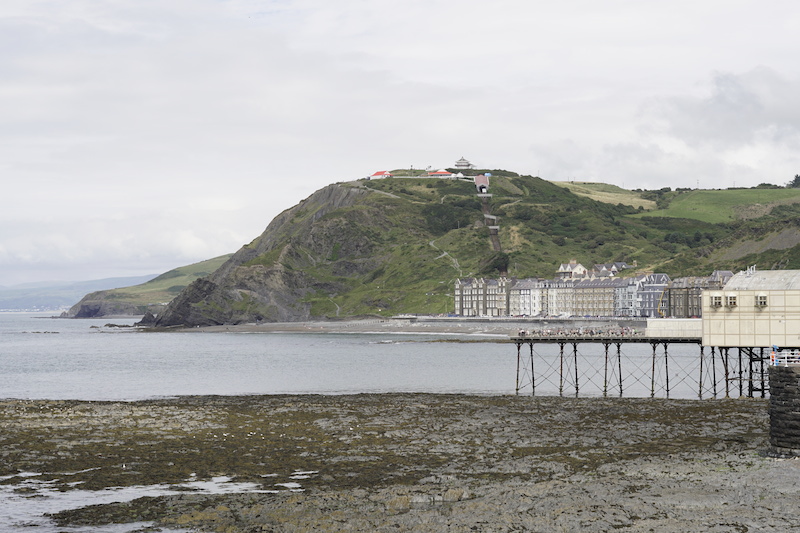

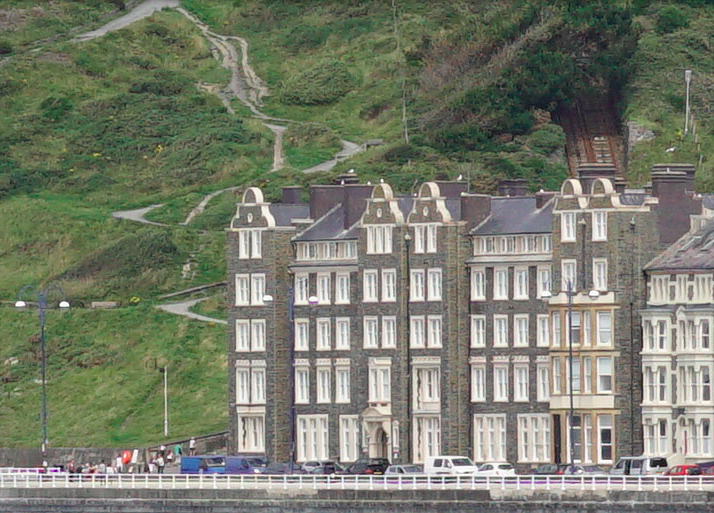
Dynamic Range
Moving on to dynamic range, if we recover all the shadows and highlights from the RAW files in Lightroom, we find that the a6300 does a slightly better job of suppressing colour noise and retaining detail than the GX85.
Realistically, you can recover around two stops with the GX85 before you start to see noise, while the a6300 can be pushed a little further depending on the situation. (And remember that you can always bracket your images and merge them in post production!)




High ISO Performance
Although the high ISO performance of both cameras is excellent, the a6300 controls noise more effectively overall, particularly at the higher values.
Up to 3200 ISO, the performance is almost identical. Starting from 6400 ISO, we begin to see a little more noise from the GX85 especially in the darker areas, and at 12800 and 25600 the a6300 takes a clear lead. The a6300 at its maximum ISO value of 51200 performs much like the GX85 at its maximum ISO value of 25600.
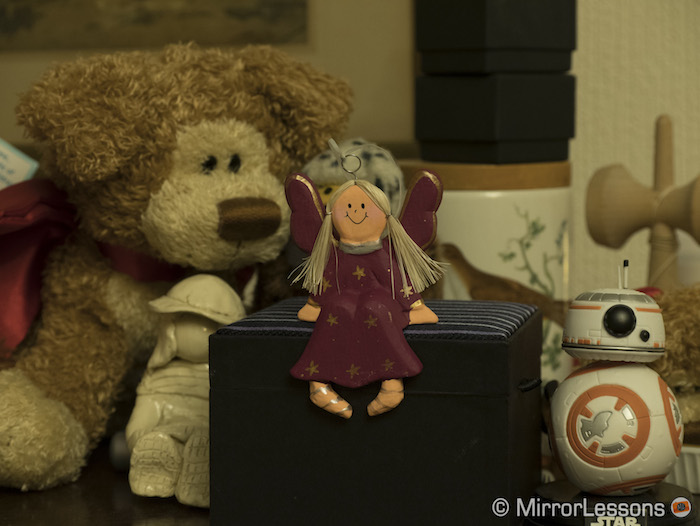
Click to see a high resolution version of the following 100% crops.
How far can you realistically push these cameras? Obviously it depends on your personal tolerance for noise and where the images will end up but for web use or a newspaper, I would be quite comfortable shooting up to 6400 ISO on the GX85 and 12800 on the a6300. Were I producing fine prints, I wouldn’t go any higher than 800 ISO with either camera.
White Balance
When set to the same white balance, the results are very similar, with the yellows and oranges appearing warmer and the purples appearing cooler from the GX85.
Below is a side-by-side example taken at 6200 Kelvin with the same exposure and the Standard picture profiles. Both are out-of-camera JPG crops.


As for the automatic white balance, the a6300 appears to produce a cooler tint than the GX85. Of course, this only applies to the in-camera JPGs; you can easily adjust the RAW files to your liking in post-production.
Out-of-camera JPGs
Both cameras offer a good deal of creative control over the JPGs.
Within the Photo Style menu of the GX85, not only can you select the style (Standard, Vivid, etc.) but it is also possible adjust the contrast, sharpness, noise reduction and saturation of each style on a +/-5 scale. The same applies to the a6300 in that you can adjust contrast, sharpness and saturation directly within the Creative Style menu, albeit only on a +/-3 scale. Noise reduction is found within a different menu and can be set of Off, Low or Standard.
Overall, I really like the quality of the JPGs from both cameras – the colours are natural and there is a good amount of detail. Regarding noise reduction, I prefer to keep both cameras set to their respective mid-range values (Low on the a6300 and 0 on the GX85) to avoid the smudging that comes with extreme NR while reducing the colour noise that can appear if you leave the NR settings to Off.
Interestingly, the a6300 also comes with an Extra Fine JPG option which offers less compression than the Fine version, and the GX85 benefits from an L.Monochrome profile which has a more “film-like” appearance.

Autofocus, Manual Focus and Performance
A monumental difference between the two GX85 and a6300 is their respective autofocus systems.
Along with the Fujifilm X-Pro2 and X-T2, the a6300 has one of the quickest and most reliable autofocus systems of all mirrorless cameras. It incorporates an advanced 4D FOCUS™ hybrid autofocus system consisting of 169 contrast and 425 phase detection points across the sensor. This, combined with a new mode called High-Density Tracking AF which surrounds a subject with phase detection points, allows the camera to track moving subjects with ease, regardless of its position within the frame.
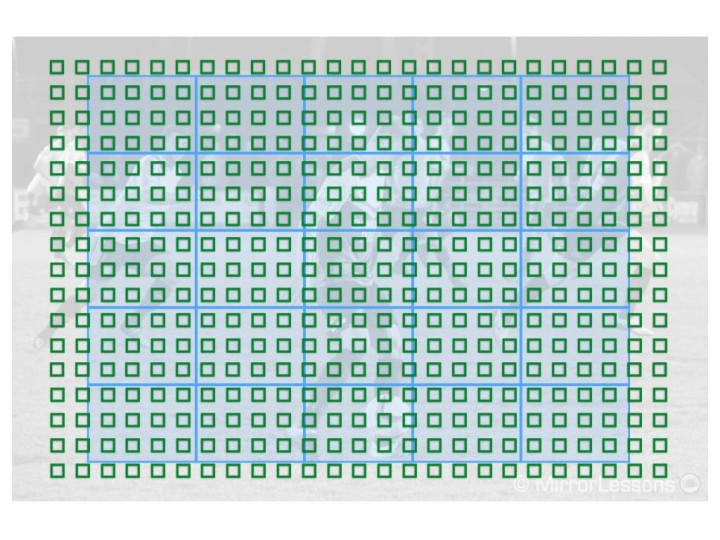
The GX85 employs Panasonic’s Depth from Defocus (DFD) autofocus technology. Being a contrast detection autofocus system with only 49 areas, it doesn’t work quite as effectively as the a6300’s system for tracking but it can easily take on slower subjects and is lightning fast in single point mode.
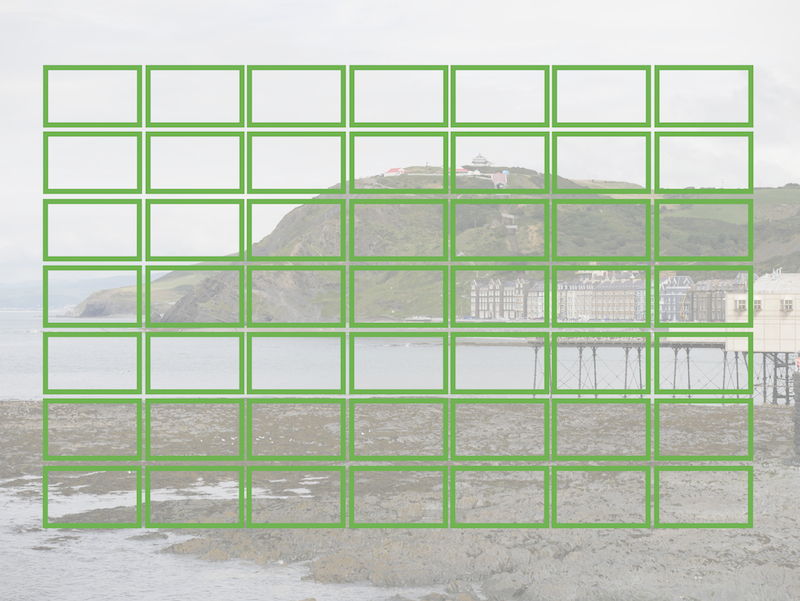
Both cameras come equipped with the traditional single, continuous, and manual focus modes, as well as a hybrid mode called AF-A on the a6300 and AFF on the GX85 that automatically switches between single and continuous according to subject movement. The a6300 also comes with an additional DMF mode that lets you make fine adjustments after the focus is locked.
As for the focus areas, they are named differently but allow you to manipulate the AF points in more or less the same way. For example, Wide on the a6300 is equal to 49-area on the GX85, Zone is similar to Custom Multi, and Flexible Spot performs like 1-Area. You also have tracking options called Lock-On AF on the a6300 and Tracking on the GX85, and Face/Eye detection.
Side note: It is much easier to change the focus area or AF point on the GX85 because of the screen’s touch capabilities. Using buttons to activate and change the focus point on the a6300 can be a hassle and cause you to waste precious time.
On the a6300, the maximum burst speed is 11 fps in S-AF and C-AF, contrasting with the GX85’s maximum burst speed of 8 fps in S-AF and 6 fps in C-AF. However, by switching to Super High mode, you can shoot JPGs at up to 40 fps with the GX85’s electronic shutter, albeit at a reduced JPG size of approximately 3.87MP and in S-AF.
As for their respective shutter speeds, the a6300 can shoot from 30s to 1/4000 regardless of whether you use the mechanical or electronic shutter. By contrast, the GX85’s goes from 60s to 1/4000 with the mechanical shutter and 1s to 1/16000 with the electronic shutter.
The GX85 also has the better buffer of the two, firing off around 49 RAW + JPG images in C-AF at 6 fps before the buffer slows down as opposed to only 25 images on the a6300.


Below you can see a series of images of Mat running towards me taken with both cameras. Both were taken in continuous AF (8 fps for a6300, 6fps for GX85) using the Zone mode on the a6300 and the Custom Multi mode on the GX85, which are my favourite modes for predictable single subjects that fill the frame or small groups. As you can see, the a6300 is better at locking onto and following a moving subject.
Green means perfectly in-focus / Yellow means slightly out-of-focus / Red means completely out-of-focus
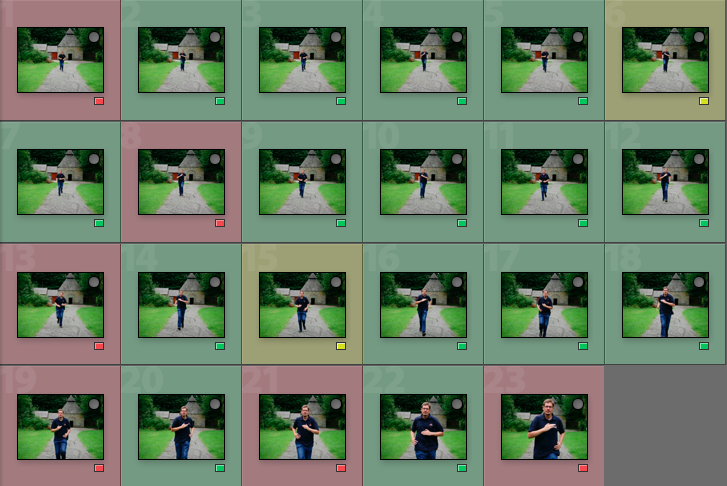
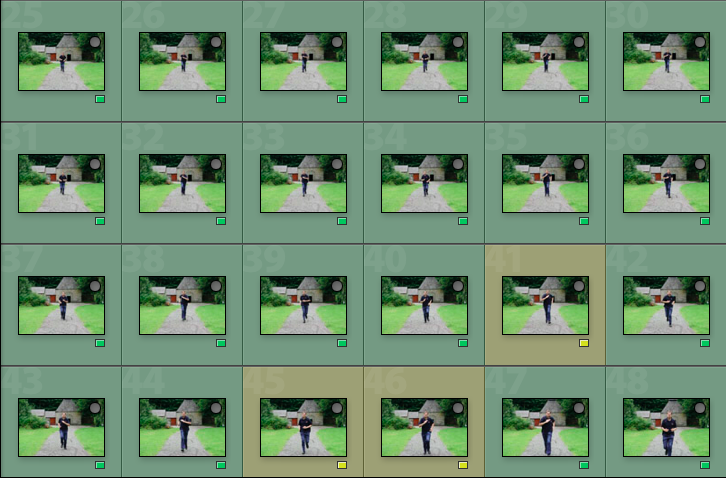
The a6300 also offers the possibility to adapt A-mount and third-party DSLR lenses to the a6300 via a simple mount adapter, allowing you to take advantage of the phase detection autofocus system. This means that any essential focal ranges missing from your collection can be covered by non-E-mount lenses, though the AF performance depends on the lens and adapter used. Keep in mind that the size of the camera is not suited to bulky DSLR lenses or long zoom lenses.
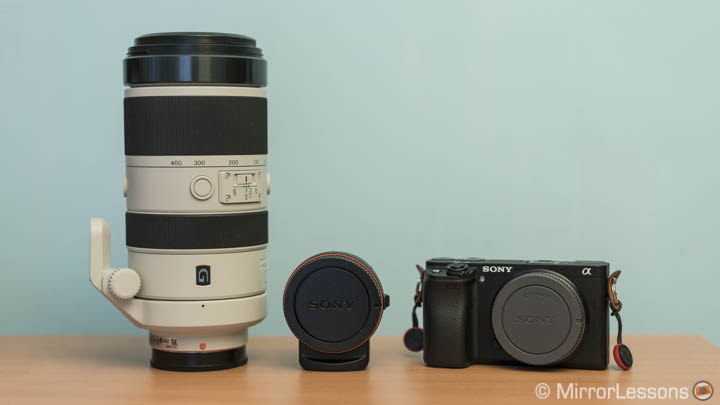
The manual focus experience is good on both cameras thanks to the various assists such as focus peaking of different intensities and colours, and magnification. However, we must be mindful that the manual focus experience with any camera will also depend on the lens and the quality of its focus ring.
In-Body Stabilisation
Another difference that could make or break your decision is the presence of in-body stabilisation on the GX85. It incorporates an updated version of Panasonic’s Dual I.S. system which combines the camera’s 5-axis in-body stabilisation with the Power O.I.S. of select Lumix lenses.
According to Panasonic, it provides 4.5 stops of compensation and our tests confirm that it works extremely well. With wide angle lenses, it is possible to take 1 second exposures hand-held with a very steady hand and we even managed a hand-held exposure that was close to 1 second at 100mm (200mm in full-frame terms).


For lenses that don’t have optical stabilisation, the 5-axis in-body stabilisation on its own is enough to compensate for shakes at equally slow shutter speeds, although it is more effective at wide than telephoto angles.
Dual I.S. also provides compensation for video shooting with the added benefit of electronic stabilisation. It is so effective for static shots that it almost looks as if you are shooting on a tripod. However, when you pan or move with the camera, you may come across some rather ugly distortion artefacts.
Below you can find a video showing the performance of the GX85’s in-body stabilisation for video in comparison to a similar product on the mirrorless market, the Olympus Pen F.
When the a6300 was announced, people expressed disappointed at the lack of in-body stabilisation, especially since 5-axis stabilisation had already made its way onto the second generation A7 series. Given that the a6300 is being marketed as a sports camera, Sony probably regarded sensor stabilisation as a superfluous feature that would only succeed in raising the price of the body, thus alienating budget-sensitive customers.
Happily, many Sony E-mount lenses incorporate optical stabilisation, though I have to say it isn’t quite as effective as Panasonic’s Dual I.S. system.
Video
4K video has become a standard feature on many mirrorless cameras and the a6300 and GX85 are no exception.
The a6300 is the first interchangeable lens E-mount camera with an APS-C sized sensor to shoot 4K. The camera does full pixel readout by using 20MP on the sensor, which corresponds to 6K of resolution, and then downscales the data to 4K. It does this without cropping the sensor (except at the top and bottom to get the 16:9 aspect ratio) meaning that the field of view doesn’t change. It shoots at up to 30fps in 4K and 120fps in Full HD, and uses the XAVC S codec for high bit-rate recording (100Mbps in 4K or 50Mbps in Full HD). Also present is a dedicated HFR (High Frame Rate) mode that conforms the 120fps footage to 25 or 30fps in-camera.
The GX85 isn’t the first Panasonic camera to shoot 4K but it is the first to combine 4K with in-body stabilisation. Like the a6300, it records at up to 30fps in 4K at a high bit-rate of 100Mbps, while in Full HD, this drops to 50fps at 28Mbps. It crops the sensor a little to offer full pixel readout, so the field of view changes in comparison to still shooting.
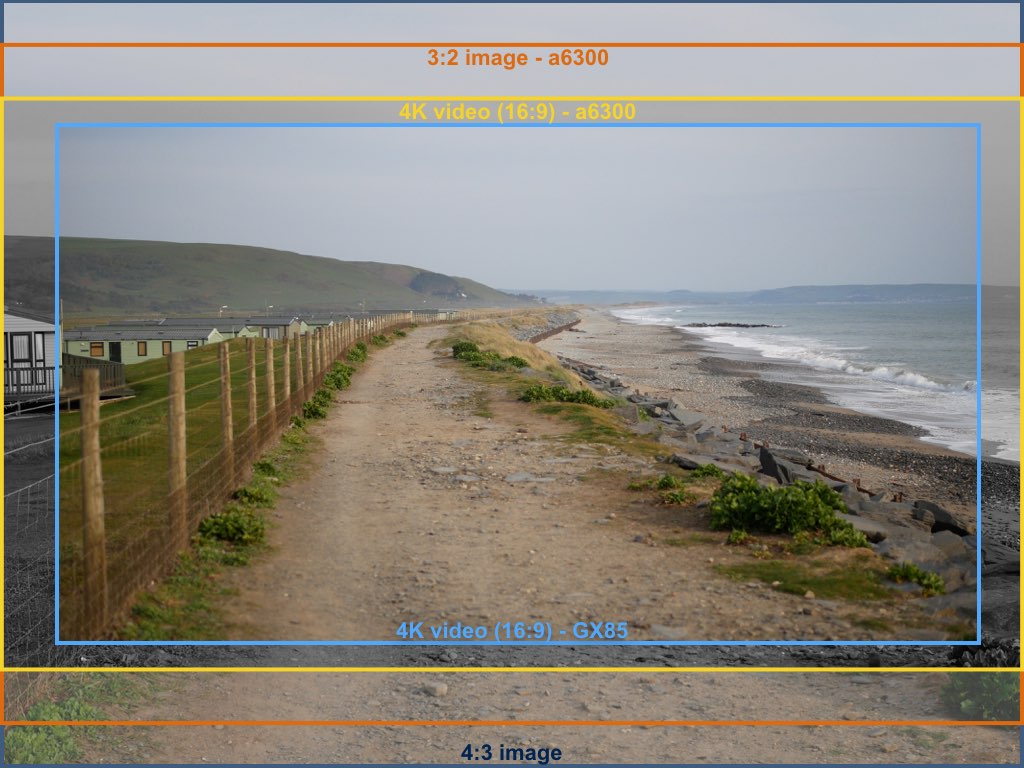
The a6300 has a wider ISO range for movies, being able to film as high as 25600 ISO in comparison to the GX85’s maximum value of 6400 ISO. It is also better at following moving subjects in continuous autofocus mode thanks to its hybrid autofocus system.
Both cameras have their own unique array of movie-related features. Along with nine dedicated picture profiles for video including S-log2 and S-log3 gamma, the a6300 also comes with various Marker Displays/Settings for movies and a built-in mic input. The GX85, on the other hand, benefits from stop motion animation, time-lapse, pull-focus and 4K cropping and panning in-camera. The only feature it really lacks is the CineLike D profile of other 4K-capable Lumix cameras.
Both models offer zebra patterns and clean HDMI output in 4K (4:2:2 8-bit).
One issue we encountered with the a6300 was overheating. After 10/15 minutes of continuous shooting, the display will show a symbol notifying you of the problem. Leave it running for an additional few minutes and the camera will stop recording. The problem doesn’t occur all the time so it is difficult to say if it is a major issue or not. Sony recently released a firmware update (version 1.10) to address this. We tested it and overheating appeared after one hour of continuous recording (two 30minutes clips one after the other).
Below we’ve compiled a short clip to show you how the video performance compares. You will notice that the a6300 has more dynamic range thanks to the S-Log2 gamma while the GX85 has the advantage of in-body stabilisation. Rolling shutter is a little more severe on the Sony camera.
Additional Features
In terms of extra photo-related features, I have to give the prize to the GX85 for one simple reason: they are all included with the camera software. The most interesting are as follows:
- 4K Photo: Lets you extract an 8MP JPG from 4K footage shot at 30fps in three different ways.
- Post Focus (4K Photo feature): Choose your focus point on-screen after taking the image.
- Light Composition (4K Photo feature): Only adds new bright pixels to an image to avoid overexposing the brightest elements in your frame. Good for light painting, fireworks or star trails.
- Multiple Exposure: Layers two or more exposures to create a surreal composite.
Keep in mind that the above functions only produce JPGs, not RAW files.
On the a6300, the only option is to download camera apps from the Sony PlayMemories website, a process which is at best cumbersome and at worst unworkable. Moreover, the apps cost money, so not only are you paying for a body that costs nearly $1000 but you’re also shelling out for apps that other camera companies like Panasonic include for free.
That being said, there are a few features that come with both cameras. They are as follows:
- Panorama: Stitches together multiple images after panning to create a panorama.
- Silent Shutter: Use the electronic shutter to shoot in complete silence.
- Bracketing: Exposure / white balance / flash on the a6300 and exposure / white balance / focus / aperture on the GX85.
- WiFi Connectivity: Connect to your smart device, use it as a remote to control the camera or upload photos. Note that the a6300 also has NFC capabilities.
Battery Life
According to the official specifications, the GX85 can fire off around 260-290 shots on one charge while the a6300 can manage between 350-400, but for real-world shooting, I’ve found that both last about the same amount of time. Of course, the more you use power-hungry features like 4K video or the EVF at its highest frame rate, the faster the battery life will drain. To be safe, I usually carry around at least two batteries for a day of casual shooting, and a couple more if I plan to shoot lots of video.
Price
As of today, the GX85 with the kit lens costs around $800, making it about $350 cheaper than the a6300 with the kit lens. The affordable price of the former has earned it the nickname “the new a6000” because it packs so many interesting features without costing an arm and a leg.
Conclusion
Having spent so much time with both cameras, I have developed a very clear idea of when I’d use one or the other and why.


The GX85 is my go-to camera for 4K video because of its user-friendly menu system, touch sensitive screen and various extra video-related features. Granted, it lacks the video-specific picture profiles and microphone jack of the a6300, but it doesn’t have the tendency to overheat, comes with excellent in-body stabilisation that also works for video, and produces beautiful 4K and Full HD footage.
For any kind of action photography, however, my first instinct would be to use the a6300. Its hybrid autofocus system offers a hit rate that is unprecedented on a mirrorless camera with the exception of the latest Fujifilm models and the Live View up to 8fps is very useful for following fast-moving subjects. Paired with the FE 70-200mm f/4, you have an unbeatable combo in terms of speed and portability.
For general still shooting, either camera will do the job. The 24MP of the a6300 will give you more leeway to crop in post-production but the 16MP of the GX85 is perfectly adequate for most purposes. In low-light, the a6300 has an advantage over the GX85 from 6400 ISO onwards but since the GX85 has excellent in-body stabilisation and the Micro Four Thirds system provides many fast lenses, you can usually keep your ISO values low by selecting a slow shutter speed and fast aperture. And even though the a6300 has better dynamic range, the GX85 defends itself well.
If I had to recommend one of these two products to a photographer with a broad range of interests, it would likely be the GX85 because, along with being the more well-rounded product of the two, it is also less expensive and has a wider range of lenses at its disposition. The a6300, while an excellent camera, belongs in the hands of a photographer whose passion is action photography, and shoots this genre on a regular basis.
Choose the Panasonic GX85 if:
- you do lots of hand-held still and video shooting
- you like the flexibility of a touch sensitive screen
- you want to spend as little as possible on a 4K-capable body
Choose the Sony a6300 if:
- you shoot lots of action photography
- you feel you could take advantage of the S-Log profiles and better high ISO performance for video
Check price of the Lumix GX85 / GX80 on
Amazon | Amazon UK | eBay | B&H Photo
Check price of the Sony a6300 on
Amazon | Amazon UK | eBay | B&H Photo
Second-hand Sony cameras on
Second-hand Panasonic cameras on
Additional Images













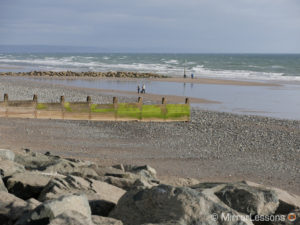
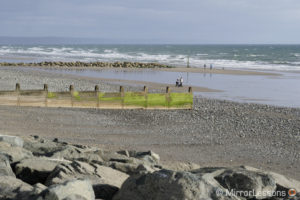


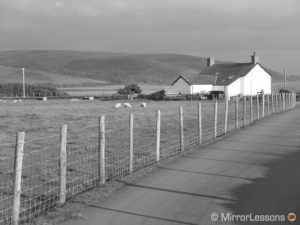
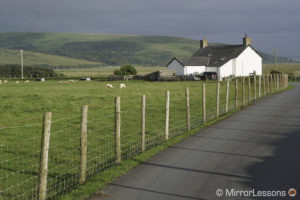
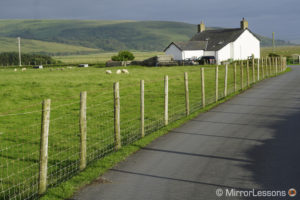
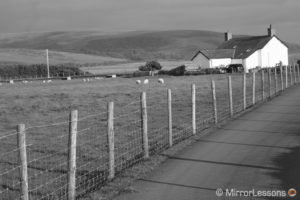
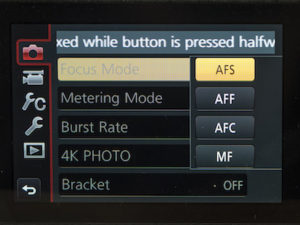
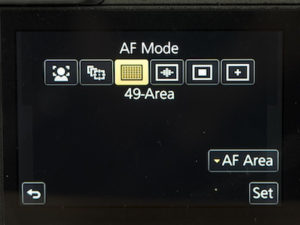

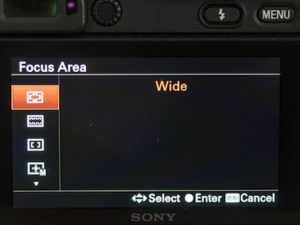
What a coincidence, I just published my own review of the Lumix GX80 at the same time as you! I have never tried the Sony alpha cameras, so I can’t compare, but for those looking for a detailed comment on the Lumix camera, feel free to visit my blog, with plenty of pictures:
http://gonzalobroto.blogspot.com/2016/09/on-names-and-choices-review-of-lumix.html
linking to your own “review” on someone else’s is a bit cheeky , giving yourself a thumbs up is a little desperate lol
If your nickname is a reference to Koreeda’s movie, thumbs up, you have good cinematographic taste!
Yet another excellent comparison. I’d like to have seen a section on the ecosystem around the 2 bodies however.
Sony’s support of the E mount (or lack thereof) seems to get a free pass by so many reviewers. You’d think that after their apparent abandonment of the A mount, people would be a bit more sensitive on the matter.
Great comparison! Thanks for the very detailed analysis. The wide range of high quality optics for Micro-Four Thirds, including Leica designed lenses and Olympus Pro lenses, and the their very affordable prices (relative to other systems) is something worth considering.
The most important aspect are the lenses.
If someone mainly uses the kitlenses 16-50 or 18-55 with sony he will never get any real advantage of the bigger sony-sensor.
You have to close the aparture 2-3 stopps more than with any mft lense to get a good sharpness over the whole frame which is very important for landscapes.
The smaller mft sensor in combination with the kits like a 14-42 or 12-32 delivers much sparper images wide open, not in the center, but to the borders and corners.